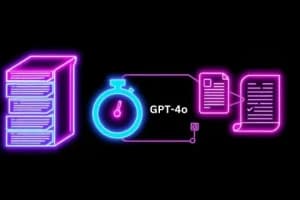Text summarization is undoubtedly important because, in this era, every business and single individual is clouded by large amounts of information. These documents can be research papers, legal documents, company financial reports, etc., but the summarization of such texts becomes important to derive meaningful insights rapidly. Enter LangChain, which is a powerful framework for understating large language models (LLMs) into external tools to come up with advanced text-summarising solutions.
Here, in this blog, we will examine the efficiency of LangChain in text summarization and discuss its components with practical examples.
Understanding Text Summarization and Its Challenges
Text summarization is the activity of transforming large text documents into small summaries that contain the most important information. It can be categorized into two types:
- Extractive Summarization: Select and combine the most relevant sentences or phrases from the source text.
- Abstractive Summarization: To paraphrase it means to create brand new sentences that express the general meaning of the entire text.
Despite its promise, summarization faces challenges:
- Handling Large Documents: The analysis of large text corpora goes beyond the token resources of many LLMs.
- Maintaining Context: When the text is divided into many parts, background information may be omitted, which may confuse the reader.
- Domain-Specific Knowledge: Documents such as legal contracts or medical papers cannot be summarized with the domain-unaware method.
In response, LangChain proposes a modular approach to meet these requirements to accommodate the needs of developers to build custom libraries for summarizing big documents.
What is LangChain?
LangChain is a completely open-source framework for developing language model applications while providing the facilities to include LLMs as an outside tool or produce a personalized workflow to perform natural language tasks such as summarization, customer support query resolution, and so on.
LangChain also has pre-assembled components through which users can build very flexible processing pipelines around large documents and other more complex types of language processing. Document Loaders allow for reading documents in all file formats, Text Splitters split long texts into smaller segments, and Chains take multiple tasks and combine them into a seamlessly integrated process.
LangChain for summarization allows workstreams to be more dynamic and results to be much more accurate and context-preserving than traditional summarization methods-for instance when working with longer text bodies.
How LangChain Simplifies Text Summarization
LangChain is designed to integrate with large language models while addressing the limitations of traditional approaches. It provides a robust framework for building pipelines that load, split, and process text efficiently.
Core Components of LangChain
1. Document Loaders
Purpose: Extract content from various file formats such as PDFs, web pages, Word documents, or raw text files.
Example: Load a PDF Document
from langchain.document_loaders import PyPDFLoader
# Load a PDF file
loader = PyPDFLoader("example_document.pdf")
documents = loader.load()
# Display the content of the first page
print(documents[0].page_content)Use Case: Extract content from an academic paper or a legal contract for summarization.
2. Text Splitters
Purpose: Split lengthy text into smaller, manageable chunks without losing meaning. This is essential for handling long documents that exceed token limits of language models.
Example: Splitting Text into Chunks
from langchain.text_splitter import RecursiveCharacterTextSplitter
# Initialize the text splitter
text_splitter = RecursiveCharacterTextSplitter(chunk_size=1000, chunk_overlap=200)
# Split the loaded documents
chunks = text_splitter.split_documents(documents)
# Display the first chunk
print(chunks[0].page_content)Use Case: Divide a large research paper into smaller sections for better processing by an LLM.
3. Chains
Purpose: Combine multiple steps of a processing pipeline, such as summarization, question-answering, or retrieval-based tasks.Example: Summarization Chain
from langchain.prompts import PromptTemplate
from langchain.llms import OpenAI
from langchain.chains import LLMChain
# Define the prompt template for summarization
prompt = PromptTemplate(
input_variables=["text"],
template="Summarize the following text: {text}"
)
# Initialize the LLM
llm = OpenAI(temperature=0)
# Create a chain for summarization
summarization_chain = LLMChain(llm=llm, prompt=prompt)
# Run the chain on a chunk of text
summary = summarization_chain.run(chunks[0].page_content)
print(summary)Use Case: Automate the process of summarizing different sections of a document in a pipeline.
4. Prompt Templates
Purpose: Customize the instructions sent to the LLM for specific outputs, ensuring the results align with your needs.
Example: Custom Prompt for Key-Point Extraction
prompt = PromptTemplate(
input_variables=["text"],
template=(
"Extract the key points from the following text. Return them as a bulleted list: {text}"
)
)
# Use the same chain as above, replacing the summarization prompt
key_points = summarization_chain.run(prompt.format(text=chunks[0].page_content))
print(key_points)Use Case: Extract actionable insights or important details from a lengthy meeting transcript.
5. Memory and Context Management
Purpose: Retain context across long conversations or multi-step tasks, making it easier to manage workflows that require multiple interactions with the LLM.
Example: Memory Retention for Multi-Step Summarization
from langchain.memory import ConversationBufferMemory
from langchain.chains import ConversationalRetrievalChain
# Initialize memory
memory = ConversationBufferMemory()
# Create a conversation chain with memory
conversational_chain = ConversationalRetrievalChain(
llm=llm,
retriever=None, # Optional retriever for external data
memory=memory
)
# First interaction: Summarize a section
response1 = conversational_chain.run(input="Summarize this text: " + chunks[0].page_content)
print(response1)
# Second interaction: Ask a follow-up question while retaining context
response2 = conversational_chain.run(input="Can you elaborate on the second point?")
print(response2)Use Case: Process large documents in steps while keeping track of previous summaries or outputs.
How These Components Work Together
When summarizing large documents:
- Document Loaders identify the content from raw files or URLs.
- Text Splitters separate the material into smaller parts to later process them in synchronism.
- Synchronization of the summarization pipeline is done with the use of chains.
- Prompt Templates change the LLM's operation to produce specific responses.
- Memory and Context Management preserve previous outputs for repeated processing.
Together, these tools make LangChain a robust framework for text summarization and other LLM-powered applications. For hands-on learning, you can explore projects available on our site.
Step-by-Step Implementation
Here's a step-by-step implementation of your LangChain workflow using Hugging Face's local summarization model, explained in short sentences.
Step 1: Install Required Libraries
!pip install langchain transformers
!pip install openai
!pip install requestsExplanation: Install the necessary libraries for LangChain, Hugging Face's Transformers, and Requests.
Step 2: Load Hugging Face Summarization Model
from transformers import pipeline
from langchain.llms import HuggingFacePipeline
# Load a Hugging Face summarization model
summarization_pipeline = pipeline("summarization", model="facebook/bart-large-cnn")
# Create an LLM instance for LangChain
llm = HuggingFacePipeline(pipeline=summarization_pipeline)Explanation: Load the BART model for summarization and wrap it in LangChain's HuggingFacePipeline.
Step 3: Define Prompt Templates
from langchain.prompts import PromptTemplate
# Define the prompt template for summarizing chunks
map_template = """Write a concise summary of the following content:
{content}
Summary:
"""
map_prompt = PromptTemplate.from_template(map_template)
# Define the prompt template for reducing summaries
reduce_template = """The following is a set of summaries:
{doc_summaries}
Summarize the above summaries with all the key details:
Summary:
"""
reduce_prompt = PromptTemplate.from_template(reduce_template)Explanation: Define templates to prompt the model for summarizing chunks and reducing summaries.
Step 4: Create Map and Reduce Chains
from langchain.chains import LLMChain
from langchain.chains.combine_documents.stuff import StuffDocumentsChain
from langchain.chains import ReduceDocumentsChain, MapReduceDocumentsChain
# Create the Map Chain
map_chain = LLMChain(prompt=map_prompt, llm=llm)
# Create the Reduce Chain
reduce_chain = LLMChain(prompt=reduce_prompt, llm=llm)
stuff_chain = StuffDocumentsChain(
llm_chain=reduce_chain, document_variable_name="doc_summaries"
)
# Combine the Map and Reduce Chains
reduce_documents_chain = ReduceDocumentsChain(combine_documents_chain=stuff_chain)
map_reduce_chain = MapReduceDocumentsChain(
llm_chain=map_chain,
document_variable_name="content",
reduce_documents_chain=reduce_documents_chain
)Explanation: Use LangChain's components to create Map and Reduce chains for summarization and combine them into a MapReduce Chain.
Step 5: Fetch Content from a Webpage
import requests
# Fetch document content from a webpage
url = "https://lilianweng.github.io/posts/2023-03-15-prompt-engineering/"
response = requests.get(url)
document = response.text[:3000] # Limit the size of the document for testingExplanation: Use the Requests library to fetch content from a URL and limit its size for testing.
Step 6: Split the Document into Chunks
from langchain.text_splitter import TokenTextSplitter
from langchain.schema import Document
# Split the document into smaller chunks
splitter = TokenTextSplitter(chunk_size=500)
split_docs = splitter.split_documents([Document(page_content=document)])Explanation: Split the document into smaller chunks using LangChain's TokenTextSplitter.
Step 7: Run the MapReduce Chain
# Run the MapReduce Chain on the split document chunks
summary = map_reduce_chain.run(split_docs)
# Print the final summary
print("Final Summary:\n", summary)Explanation: Pass the split document chunks to the MapReduce Chain to generate a summary.
Step 8: Output the Summary
Final Output: The workflow will process the chunks and generate a summarized version of the document.
Example Output
For a blog on prompt engineering:
Final Summary:
Prompt Engineering, also known as In-Context Prompting, refers to methods for how to communicate with LLM to steer its behavior. The effect of prompt engineering methods can vary a lot among models, thus requiring heavy experimentation and heuristics. This post only focuses on prompt engineering for autoregressive language models.This step-by-step implementation demonstrates the LangChain-based summarization workflow, leveraging a Hugging Face model for local processing. Let me know if you have more questions.
Real-World Applications of LangChain for Summarization
LangChain's versatility makes it suitable for various industries and use cases:
1. LangChain with End-to-End Projects
Description: This repository has a compilation of projects that are built in both leveraging local models (the Ollama) as well as API and different use cases of LangChain.
GitHub Link: LangChain with End-to-End Projects
2. End-to-End LLM Project with LangChain and SQL
Description: This project combines Google PaLM as well as LangChain to support natural language relating to a MySQL database system.
GitHub Link: End-to-End LLM Project with LangChain and SQL
3. End-to-End RAG Project using ObjectBox and LangChain
Description: This project demonstrates a Retrieval-Augmented Generation (RAG) project with ObjectBox Vector Database and LangChain for on-device AI with no data leaving the device.
GitHub Link: End-to-End RAG Project using ObjectBox and LangChain
These repositories offer hands-on guidance in developing applications from start to finish using LangChain, including many cases and combinations.
Get Started Today
Text summarization is an essential skill for making sense of large volumes of information. LangChain provides the tools to transform how you process and analyze text, whether for personal projects or professional use.
Explore our hands-on AI Projects to start building your summarization tools today:
Document Summarization Using Sentencepiece Transformers
This project has you covered well! In this project, we're equipping ourselves with cutting-edge AI tools such as SentencePiece and Transformers by diving into the world of document summarization. Build your skills, enhance your portfolio, and harness the power of AI to revolutionize the way you work with text. Get Started Now!
Conclusion
LangChain is a game-changer for text summarization, especially for large documents. Its modular approach, coupled with LLMs, empowers developers and businesses to tackle complex summarization tasks efficiently. By integrating LangChain into your workflow, you can unlock the full potential of LLMs for extracting meaningful insights from large volumes of text.
If you're a beginner, dive into LangChain with simple projects and gradually explore advanced features. The possibilities are endless!
FAQ
Q1. Is LangChain suitable for beginners?
Indeed, the LangChain project is easy to approach, especially with documentation and plenty of posts made in the community. You can start with code like the Basic Text Summarizer or Question-Answering Bot for beginners.
Q2. Which industries may find the LangChain text summarization feature valuable?
LangChain is widely used across industries, including:
- Legal: Automating contract analysis.
- Healthcare: Patient day summaries and clinical trial overviews.
- Education: Summarizing accumulated research papers or notes taken in a lecture.
- Business: Condensing from reports they had compiled or meetings they had attended.
Q3. How do I access the projects?
Visit our AI Projects Page to explore available projects. Simply select the project of your choice and follow the instructions to get started.
Q4. How does LangChain work in the case of long documents?
Text-splitting components can be used so that big documents can be chunked and processed through LLMs. Thus, it won't reach the token limit while reading in the management. Plus, the multi-step workflow can be managed easily with memory and context management.







